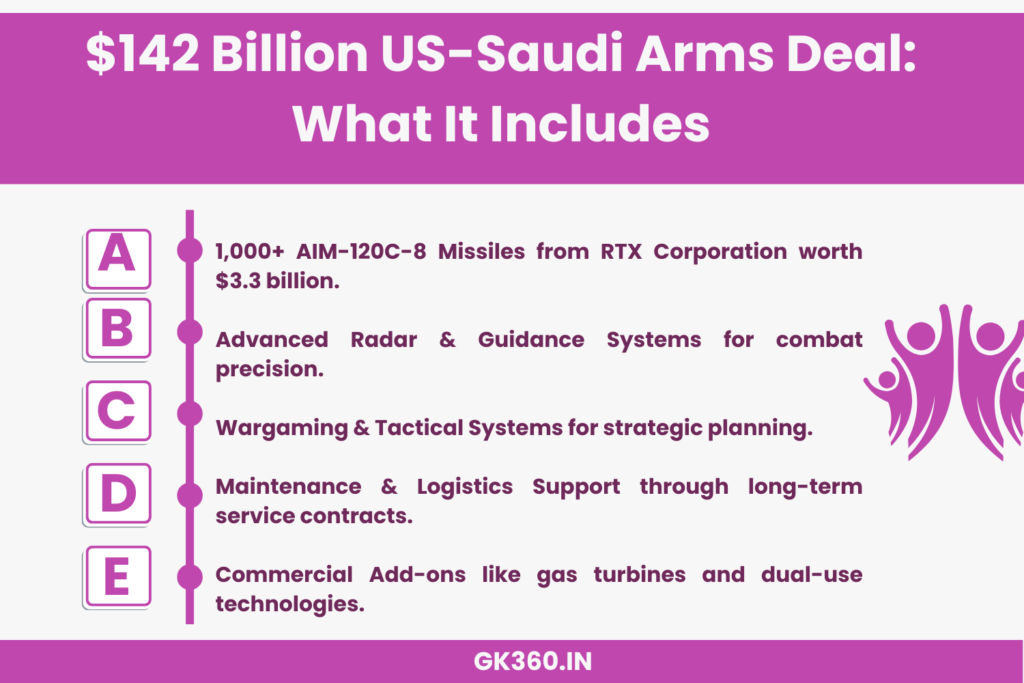US-Saudi $142 Billion Arms Deal: Trump’s Landmark Move to Strengthen Gulf Security and Defence Ties
In a bold move to reshape defence alliances and regional security, the United States and Saudi Arabia signed a historic $142 billion arms agreement during President Donald Trump’s official visit to Riyadh in May 2025. Described as the largest arms deal in modern history, this transaction marks a new chapter in US-Saudi strategic relations, aiming to deter threats in the Gulf—particularly from Iran—while energizing the US defence manufacturing sector.
As geopolitical dynamics shift and military readiness becomes paramount, this deal reinforces America’s position as a global defence leader and Saudi Arabia’s drive to modernize its armed forces under Vision 2030.

Table of Contents
- Background: Why This Arms Deal Is Historic
- Deal Highlights: What the $142 Billion Covers
- Strategic Goals of the Agreement
- Related Announcements and Broader Vision
- Key Stakeholders and Corporate Involvement
- Implications for Regional Security and US Foreign Policy
- FAQs About the US-Saudi Arms Deal
- Conclusion: Shaping the Future of Middle East Diplomacy
Background: Why This Arms Deal Is Historic
This $142 billion US-Saudi arms pact is not just a defence transaction—it’s a strategic signal. Announced during President Trump’s second term, the deal reflects a recalibration of US foreign policy, where economic diplomacy, defence exports, and regional influence are tightly interwoven.
Set against a backdrop of rising tensions with Iran, this agreement serves as a cornerstone of Gulf security policy and underscores Washington’s long-term commitment to its allies in the Middle East. The magnitude of the deal also highlights Trump’s broader ambition: to integrate military strength with trade expansion and domestic job creation.
Deal Highlights: What the $142 Billion Covers
The defence package includes a wide array of advanced weaponry, support services, and commercial exports designed to transform Saudi Arabia’s military capabilities. Key components include:
- Advanced Air-to-Air Missiles: Over 1,000 AIM-120C-8 medium-range missiles, produced by RTX Corporation, valued at $3.3 billion.
- Radar & Guidance Systems: Cutting-edge radar and targeting systems for enhanced aerial and ground combat precision.
- Wargaming and Tactical Systems: Digital infrastructure and simulation technologies for strategic and operational planning.
- Logistical & Maintenance Support: Multi-year contracts for training, parts supply, and system integration.
- Commercial Exports: High-end gas turbines and dual-use technologies complement the military package, aligning defence and economic goals.
This comprehensive bundle reflects a multi-domain investment in air, electronic, and logistical warfare—aimed at boosting regional deterrence.
Strategic Goals of the Agreement
Boosting Saudi Arabia’s Military Infrastructure
The deal enables Saudi Arabia to leapfrog into the ranks of top-tier global militaries. With conflicts in Yemen and tensions along its borders, the Kingdom needs cutting-edge systems to maintain national security. This investment will support:
- Upgrades in air defence and missile interception.
- Enhanced battlefield coordination via modern C4ISR systems.
- Domestic military production under the Kingdom’s Vision 2030 reforms.
Strengthening Bilateral Relations
This arms deal signals a renewed era of trust between Washington and Riyadh. It reaffirms Saudi Arabia as one of the US’s most vital allies in the region and showcases Trump’s commitment to leveraging military diplomacy for strategic influence.
- It strengthens decades-long military cooperation.
- Demonstrates alignment on Iran deterrence and Gulf security.
- Builds the foundation for further defence and trade deals.
Stimulating the US Defence Economy
The agreement is a major win for the American defence sector, especially companies like RTX Corporation and Lockheed Martin. Economically, it translates into:
- Tens of thousands of jobs across manufacturing, logistics, and tech.
- Increased exports of US-made defence systems.
- Long-term contracts benefiting supply chains in multiple states.
This aligns with Trump’s “America First” economic policy by enhancing domestic industry through international agreements.
Securing the Gulf and Containing Iran
At its core, the deal is a direct counterbalance to Iran’s growing influence in the Gulf and beyond. The newly acquired weapon systems provide Saudi Arabia with tools to:
- Deter missile and drone threats from Iranian proxies.
- Strengthen naval and aerial surveillance in contested zones.
- Support coalition-based regional defence initiatives.
This bolsters regional deterrence while indirectly supporting US military objectives without deploying additional American forces.
Related Announcements and Broader Vision
Missile Sale Approval Preceding the Agreement
Just weeks before the full deal was inked, the US Defence Security Cooperation Agency (DSCA) approved the preliminary sale of 1,000 AIM-120C-8 missiles to Saudi Arabia. Valued at $3.3 billion, this transaction was a strategic prelude to the broader arms agreement and showcased RTX Corporation’s growing global footprint in precision weaponry.
Trump’s Middle East Tour: A Broader Diplomatic Push
President Trump’s visit to Saudi Arabia was part of a larger regional tour that included Qatar and the United Arab Emirates. The diplomatic mission focused on:
- Expanding economic cooperation with Gulf nations.
- Attracting sovereign wealth fund investments into the US.
- Strengthening joint counterterrorism initiatives.
During this tour, Saudi Arabia pledged to invest $600 billion in US industries over the next four years—a figure Trump declared could potentially reach $1 trillion, indicating a broader economic-diplomatic strategy.
Key Stakeholders and Corporate Involvement
President Donald Trump
Entering his second presidential term, Trump continues to emphasize an economic-first foreign policy, where arms deals double as tools for diplomacy and industrial stimulus. This agreement reflects his administration’s aggressive defence export strategy.
Crown Prince Mohammed bin Salman
As the architect of Saudi Arabia’s Vision 2030, the Crown Prince is modernizing the Kingdom’s military and economy. This deal aligns with his push for strategic autonomy and regional leadership.
RTX Corporation
A centerpiece of the agreement, RTX (formerly Raytheon Technologies) is supplying the AIM-120C-8 missiles and several advanced targeting systems. Headquartered in Tucson, Arizona, RTX stands to gain significantly in terms of revenue and global defence partnerships.
DSCA – Defence Security Cooperation Agency
This federal agency coordinates foreign arms sales, ensuring compliance and execution. It plays a pivotal role in aligning US military exports with national security goals.
Implications for Regional Security and US Foreign Policy
This arms deal is more than a bilateral agreement—it is a strategic recalibration of US foreign policy in the Middle East. Key implications include:
Regional Deterrence
Saudi Arabia’s bolstered capabilities serve as a direct deterrent to Iranian aggression, particularly in areas like:
- Drone warfare and missile strikes
- Proxy conflicts in Yemen and Syria
- Maritime security in the Strait of Hormuz
Shift in US Strategy
Rather than deploying troops, the US is now equipping allies with deterrent capabilities, enabling regional players to manage threats autonomously while reinforcing America’s geopolitical influence.
Industrial Diplomacy
The deal also reflects a blend of commerce and security, where diplomacy is executed through economic instruments, defence contracts, and technological collaboration.

FAQs About the US-Saudi Arms Deal
- Why is this arms deal considered historic?
It is the largest US arms sale ever, valued at $142 billion, and includes comprehensive military and commercial components, significantly impacting both geopolitics and industry. - What equipment is included in the deal?
The agreement includes advanced missiles, radar systems, wargaming tech, support services, and commercial items like gas turbines. - Which companies benefit from the deal?
Primarily RTX Corporation, along with other US defence contractors, stand to gain through long-term supply and maintenance contracts. - How does this deal affect Iran?
It serves as a strategic deterrent against Iran’s growing regional activities, giving Saudi Arabia enhanced military capabilities to respond to threats. - How does this benefit the US economy?
By boosting the defence manufacturing sector, it supports job creation and increases exports, aligning with Trump’s “America First” agenda.
Conclusion: Shaping the Future of Middle East Diplomacy
The $142 billion US-Saudi arms deal signed during President Trump’s 2025 Riyadh visit marks a paradigm shift in military diplomacy. It combines strategic intent with economic leverage, offering a blueprint for future defence partnerships.
By empowering Saudi Arabia militarily, the US reinforces its Gulf alliance, deters adversaries, and stimulates its domestic economy—all while avoiding the burden of direct military entanglement.
As the Middle East remains a hotspot for power struggles, this deal places Washington and Riyadh at the center of a new security architecture—one shaped as much by contracts and commerce as by ideology and strategy.
Key Takeaways Table
| Aspect | Details |
| Deal Value | $142 billion, the largest arms deal in modern history. |
| Key Equipment | 1,000+ AIM-120C-8 missiles, radar systems, wargaming tech, support services, and gas turbines. |
| Strategic Drivers | Enhance Saudi defence, contain Iran, stimulate US defence economy, and deepen bilateral trust. |
| Economic Impact | Thousands of US jobs, industrial stimulus, long-term contracts for RTX, Lockheed Martin, and others. |
| Geopolitical Goal | Shift from direct US military involvement to regional partner empowerment. |
| Vision 2030 Alignment | Supports Saudi Arabia’s push for domestic defence production and military modernization. |





